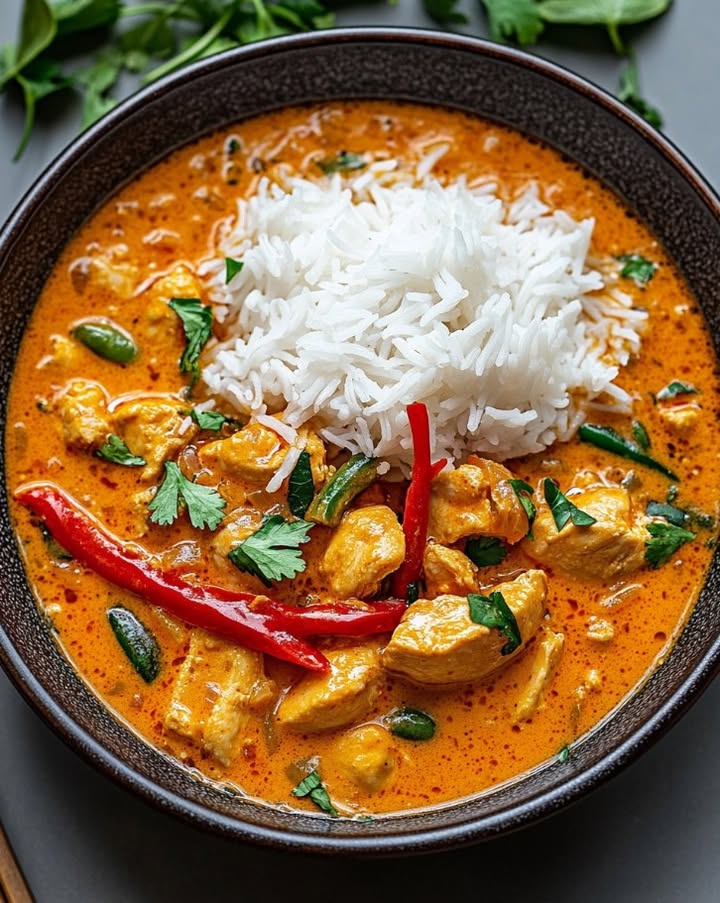
Why Panang Curry au Poulet is a Must-Try Dish
There’s something magical about the first bite of a perfectly made Chicken Panang Curry. The creamy, nutty richness of the sauce combined with tender chicken and vibrant spices is like a warm hug for your taste buds. I remember making this dish for the first time on a chilly Sunday afternoon. My kitchen filled with the aroma of toasted spices and coconut milk, and when I finally served it with steamed jasmine rice, my family couldn’t stop raving. This recipe has since become a staple in our home because it’s comforting, flavorful, and surprisingly easy to make.
A Little History Behind Panang Curry
Panang Curry originates from Thailand and is a cousin to the more famous red curry. It’s traditionally milder and creamier, thanks to the addition of peanuts or peanut butter. Historically, curries in Thailand were prepared using freshly ground spice pastes, but today, we’re lucky to have access to pre-made Panang curry paste that still delivers authentic flavor. When I first tried store-bought curry paste, I was skeptical. But after tweaking the recipe with fresh ingredients like kaffir lime leaves and Thai basil, I realized how close to “homemade” it could taste. Modern versions often include coconut milk and sometimes even a dollop of peanut butter for extra richness.
Why You’ll Love This Recipe
If you’re new to Thai cooking, this Chicken Panang Curry is a great place to start. The flavors are bold yet balanced, with a perfect mix of heat, sweetness, and creaminess. Plus, it’s ready in under an hour, making it ideal for busy weeknights or lazy weekends. One of my favorite things about this dish is how customizable it is—you can adjust the spice level to suit your family’s preferences. And trust me, once you’ve made it at home, you’ll never want to order takeout again!
Perfect Occasions to Prepare This Recipe
This dish is perfect for casual dinners with friends, cozy family meals, or even date nights. I love serving it during potlucks because it’s always a crowd-pleaser. Pair it with some chilled white wine or a cold beer, and you’ve got yourself a winning combo. It’s also a great way to impress guests without spending hours in the kitchen.
Ingredients
- 2 tablespoons of oil (coconut or vegetable)
- 3–4 tablespoons of Panang curry paste (see notes)
- 1 can (400 ml) of unsweetened full-fat coconut milk, divided
- 4 boneless, skinless chicken thighs, sliced against the grain (~900g)
- 1 tablespoon of palm sugar, coconut sugar, brown sugar, or turbinado sugar
- 2 tablespoons of fish sauce (adjust to taste, see notes)
- 1 red bell pepper, thinly sliced
- 6 kaffir lime leaves, lightly crushed
- 1 cup of snow peas (optional)
- 10 Thai basil leaves (can substitute with Italian basil), plus a few for garnish
- 3 tablespoons of natural peanut butter (see notes)
- 4 additional kaffir lime leaves, central vein removed and finely sliced (optional for garnish)
Substitution Options
No kaffir lime leaves? No problem! While they add a unique citrusy fragrance, you can skip them if unavailable. For protein, try substituting chicken with shrimp, beef, tofu, or even chickpeas for a vegetarian option. If you don’t have palm sugar, regular brown sugar works just fine. And if fish sauce isn’t your thing, a splash of soy sauce mixed with a pinch of salt will do the trick.
Step 1: Toasting the Curry Paste
Heat the oil in a large skillet over medium heat until shimmering. Add the Panang curry paste and stir frequently for about 4–5 minutes. As the paste cooks, you’ll notice its color deepen and the aroma intensify—it’s truly intoxicating! This step is crucial as it awakens the spices and sets the foundation for your curry. Pro tip: Don’t rush this process; patience here ensures maximum flavor.
Step 2: Building the Sauce Base
Once the paste is fragrant, pour in one-quarter of the coconut milk. Stir constantly until the mixture becomes glossy and thickens slightly, which should take about a minute. Next, add the chicken pieces, coating them evenly in the sauce. Cook for another minute while stirring, then pour in half of the remaining coconut milk. The sauce will start to thicken beautifully around the chicken, creating a luscious base for the rest of the dish.
Step 3: Adding Vegetables and Seasonings
Incorporate the sugar, fish sauce, sliced red bell pepper, and whole kaffir lime leaves into the pan. Let everything simmer gently for 5–8 minutes, stirring occasionally. During this time, the chicken will cook through, and the vegetables will soften slightly while retaining their crunch. If you’re adding snow peas and Thai basil, now’s the moment! These brighten up the dish both visually and flavor-wise. Pro tip: Taste as you go and adjust the seasoning to match your palate.
Step 4: Finishing Touches
Stir in the peanut butter and the last bit of coconut milk. Watch as the sauce transforms into a velvety, nutty masterpiece. Give it a final taste test and tweak the seasoning with more fish sauce or sugar if needed. Remove the whole kaffir lime leaves before serving. Garnish each plate with finely sliced kaffir lime leaves and fresh Thai basil for that extra pop of elegance.
Chef’s Tip
To elevate your Chicken Panang Curry, toast the curry paste in coconut oil instead of vegetable oil. Coconut oil enhances the tropical notes of the dish and pairs beautifully with the other ingredients.
Timing
Prep Time: 15 minutes
Cooking Time: 30 minutes
Total Time: 45 minutes
Extra Info
Did you know that Panang curry gets its name from the island of Penang in Malaysia? Although it’s now considered a quintessential Thai dish, its roots trace back to cross-cultural influences between Thailand and Malaysia. Isn’t food history fascinating?
Necessary Equipment
- Large skillet or wok
- Wooden spoon or spatula
- Measuring spoons and cups
- Sharp knife and cutting board
Storage
Leftover Chicken Panang Curry stores wonderfully in the fridge. Transfer it to an airtight container and consume within 3–4 days. Reheat gently on the stovetop or microwave, adding a splash of water or coconut milk to loosen the sauce if needed.
If you’d like to freeze it, portion the curry into freezer-safe containers. It will keep for up to 3 months. Thaw overnight in the fridge before reheating.
One word of caution: Avoid freezing the curry if you’ve added fresh herbs like Thai basil, as they may lose their vibrancy upon thawing.
Tips and Advice
- Use high-quality curry paste for the best results. Brands like Maesri are excellent choices.
- Don’t skip the peanut butter—it adds depth and richness that define Panang curry.
- Fresh kaffir lime leaves make a huge difference, so hunt them down if possible.
Presentation Tips
- Serve the curry in shallow bowls with a sprinkle of chopped peanuts for texture.
- Garnish with extra Thai basil leaves and lime wedges for a pop of color.
- Pair with fluffy jasmine rice or crispy roti bread for a complete meal.
Healthier Alternative Recipes
Here are six ways to make this dish lighter:
- Low-Fat Version: Use light coconut milk instead of full-fat.
- Vegan Option: Swap chicken for tofu and use maple syrup instead of palm sugar.
- Gluten-Free: Ensure your fish sauce is gluten-free or use tamari.
- Lower Sodium: Reduce the fish sauce and add a squeeze of fresh lime juice.
- Protein Boost: Add chickpeas or edamame for extra plant-based protein.
- Vegetable-Packed: Double the veggies by including zucchini, carrots, or spinach.
Common Mistakes to Avoid
Mistake 1: Using Old or Low-Quality Curry Paste
Using stale or low-quality curry paste can result in lackluster flavors. Always check the expiration date and opt for reputable brands. Freshness matters immensely in Thai cooking!
Mistake 2: Skipping the Toasting Step
Some people skip toasting the curry paste to save time, but this step unlocks the essential oils in the spices, giving your curry its signature depth. Take those extra few minutes—it’s worth it!
Mistake 3: Overcooking the Chicken
Overcooked chicken turns dry and rubbery. Slice it thinly against the grain and monitor closely during cooking. A meat thermometer can help ensure it reaches 165°F without overdoing it.
FAQ
What is Panang curry?
Panang curry is a type of Thai curry known for its rich, nutty flavor profile. It typically includes coconut milk, curry paste, peanuts or peanut butter, and proteins like chicken or beef. Unlike other curries, it’s often milder and sweeter.
Can I make this recipe vegetarian?
Absolutely! Replace the chicken with tofu, tempeh, or chickpeas, and swap fish sauce with soy sauce or tamari for a vegetarian-friendly version.
Where can I find kaffir lime leaves?
Kaffir lime leaves are available at Asian grocery stores or online. If you can’t find them, omit them or experiment with grated lime zest as a substitute.
How spicy is this dish?
The spiciness depends on the curry paste you use. Start with 2 tablespoons and adjust according to your heat tolerance. Remember, you can always add more spice later!
Can I use peanut butter instead of peanuts?
Yes! Natural peanut butter blends seamlessly into the sauce, providing creaminess and nuttiness. Just avoid commercial varieties with added sugars or hydrogenated oils.
What’s the difference between Panang and red curry?
Panang curry is thicker, sweeter, and milder than red curry. It also features peanuts prominently, whereas red curry focuses more on chili heat.
How long does it last in the fridge?
Stored in an airtight container, Chicken Panang Curry stays fresh for 3–4 days. Reheat gently to preserve texture and flavor.
Can I freeze this dish?
Yes, but leave out fresh herbs like Thai basil before freezing. Store in portions for easy reheating.
What sides pair well with this curry?
Jasmine rice, sticky rice, or roti bread complement the dish beautifully. A simple cucumber salad or steamed greens also work well.
Is this dish gluten-free?
By default, yes—but double-check that your fish sauce and curry paste are gluten-free. Most brands are safe, but it’s always good to verify.
Closing Thoughts
Chicken Panang Curry is more than just a meal—it’s an experience. From the intoxicating aroma of toasted curry paste to the creamy, nutty sauce enveloping tender chicken, every bite tells a story. Whether you’re cooking for loved ones or treating yourself, this dish promises comfort and satisfaction. So grab your apron, gather your ingredients, and let the adventure begin!

Chicken Panang Curry
Ingredients
Equipment
Method
- Heat the oil in a large skillet over medium heat until shimmering.
- Add the Panang curry paste and stir frequently for about 4-5 minutes until fragrant.
- Pour in one-quarter of the coconut milk and stir until glossy and slightly thickened.
- Add the chicken pieces, coating them evenly in the sauce, and cook for another minute.
- Pour in half of the remaining coconut milk and allow the sauce to thicken around the chicken.
- Incorporate the sugar, fish sauce, sliced red bell pepper, and whole kaffir lime leaves into the pan.
- Let everything simmer gently for 5-8 minutes, stirring occasionally.
- If using, add the snow peas and Thai basil.
- Stir in the peanut butter and the last bit of coconut milk, adjusting seasoning if needed.
- Remove the whole kaffir lime leaves before serving and garnish with finely sliced kaffir lime leaves and Thai basil.
